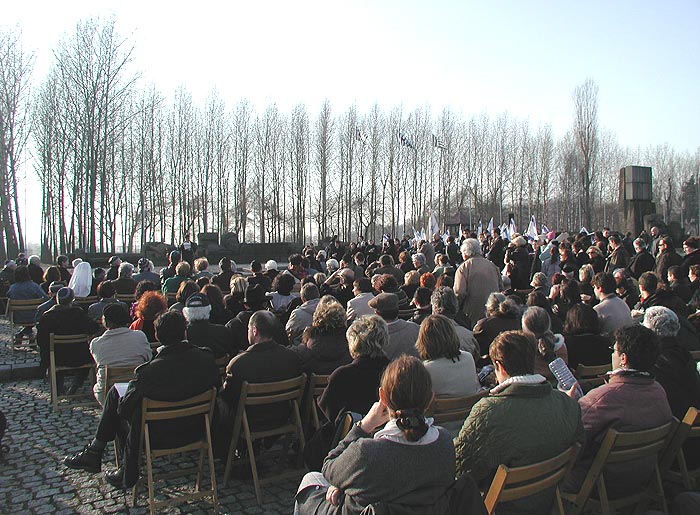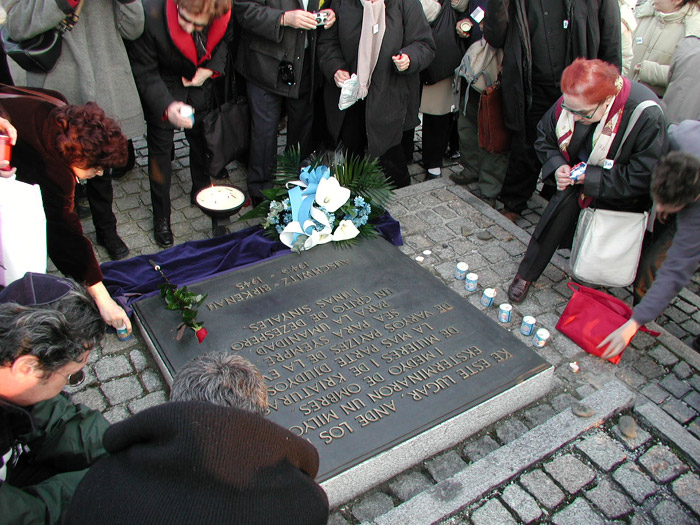
These pages are a tribute to the work of the JEAA which after three years helped obtain an international memorial for the Sephardic Jews at Auschwitz. These pages will help memorialize the historic Sephardic event, the dedication of a plaque in Judeo-Spanish which took place in March of 2003.
March 27, 2003
FOR IMMEDIATE RELEASE
Point of Contact:
S. Alfassa
salfassa @ sephardicstudies.orgRe: International Memorial at Auschwitz - Birkenau
On Monday March 24, 2003 over 300 persons from seven different countries participated in a highly emotional international memorial for Sephardic Jews. The event took place at the former Auschwitz-Birkenau concentration camp in Poland. Survivors of the Shoah, along with government dignitaries and hundreds of members of the Jewish community were in attendance when a plaque in Judeo-Spanish [Ladino] was unveiled and added to the preexisting memorial plaques.
During an international conference on Judeo-Spanish organized in Salonica (Greece) in April of 2000, survivors of the Shoah and their descendants unanimously adopted a proposal by Paris based Professor Haim-Vidal Sephiha that the memory of the Sephardic martyrs be honored by the addition of Judeo-Spanish to the existing multi-lingual memorial at Auschwitz-Birkenau. For over three years the International Committee for Judeo-Spanish at Auschwitz (JEAA) gathered written support from members and agencies of the international Jewish community. After 57 years, and with the approval of the International Auschwitz Council and the State Museum of Auschwitz, the death of hundreds of thousands of Sephardic Jews was forever memorialized. Michel Azaria, vice-president of the JEAA commented, "Finally, our brothers were able to receive the deserved recognition in their own language. A language that was unjustifiably missing."
After several dignitaries including the American and Polish Consul Generals' spoke, Kaddish was recited, then the shofar was blown. The Sarajevo-born Sephardic vocalist Flory Jagoda softly sang a song which included the lyrics, "en terras ajenas no kero morir" (in foreign lands I do not want to die). A song many prisoners sang during their internment in Auschwitz 60 years earlier. Two respected members of the Turkish Jewish community unveiled the large bronze plaque, and almost immediately members of the seven-country delegation, including many others who happened to just be visiting Auschwitz at the time of the memorial, burst into passionate tears and applause. A flood of people came up to light candles, and an impromptu crowd of Israeli youths who happened to be visiting burst out singing the Hatikva.
In Judeo-Spanish, the plaque read, "Ke Este Lugar, Ande Los Nazis, Eksterminaron Un Milyon, I Medyo De Ombres, De Mujeres I De Kriaturas, La Mas Parte Djudyos, De Varyos Payizes De La Evropa, Sea Para Syempre, Para La Umanidad, Un Grito De Dezespero, I Unas Sinyales. Auschwitz-Birkenau, 1940-1945." [For Ever Let This Place Be A Cry of Despair, And a Warning To Humanity, Where The Nazis Murdered About One and a Half Million Men, Women And Children, Mainly Jews, From Various Countries of Europe. Auschwitz-Birkenau, 1940-1945.]
Migrating after the expulsion from Spain and Portugal in the fifteenth century, Sephardim had lived throughout the lands of the former Ottoman Empire including Greece and its surrounding islands, the Balkans, and North Africa. Vibrant Sephardic communities such as those in Bulgaria, Monastir, Romania, Rhodes, Salonica and Yugoslavia (Belgrade, Zagreb, and Sarajevo) were all extinguished. Generally not known, were the thousands of Judeo-Spanish Jews in France, as well as communities in Holland, Germany and Austria. Though the Ashkenazi Jews perished in much higher numbers, the extermination of the Sephardim was so devastating, their entire living culture was virtually lost. S. Alfassa Marks, a vice-president with the New York based Foundation for the Advancement of Sephardic Studies and Culture commented on this actuality, "The mere fact that today there are no Greek or Turkish Synagogues in the Diaspora demonstrates the virtual extinction of the Judeo-Spanish Sephardic religious culture. In Salonica, the "Jerusalem of the Balkans," nearly the entire community was deported by the Germans.
Judeo-Spanish is a language of fusion, essentially 15th century Castilian, colored initially by regionalisms and Hispanic Arabicisms. After the expulsion of the Jews of Spain in 1492, additional words were absorbed from the various host countries to which they fled such as North Africa, the Balkans and Ottoman Turkey. It was the primary language of many Sephardic gedolim such as the Abravanel, Haim Yosef Azulai the "Hida," Moshe Kordovero the "RaMaK," Yacob Huli originator of the Me'am Lo'ez, and Yosef Caro author of the Shulchan Aruch (Code of Jewish Law). "It took 60 years, but the Sephardim who were murdered finally were granted representation of their memory in their own language. When an entire culture is nearly made extinct, it can never be to late to honor them," Alfassa declared.
###


